Grafting of Amine End-Functionalized Side-Chain Polybenzimidazole Acid–Base Membrane with Enhanced Phosphoric Acid Retention Ability for High-Temperature Proton Exchange Membrane Fuel Cells
Abstract
1. Introduction
2. Results and Discussion
3. Experimental
3.1. Materials and Chemicals
3.2. Synthesis of Amine-Grafted Polybenzimidazole
3.3. Preparation of Phosphoric Acid Doped AGPBI Membranes
3.4. Characterization
3.5. PA Uptake, Swelling and Acid Doping Level
3.6. Proton Conductivity and PA Retention Capacity
3.7. Positron Annihilation Lifetime Measurements
3.8. Membrane Electrode Assembly and Fuel Cell Performance
4. Conclusions
Author Contributions
Funding
Institutional Review Board Statement
Informed Consent Statement
Data Availability Statement
Conflicts of Interest
References
- Xu, J.; Zhang, C.; Wan, Z.; Chen, X.; Chan, S.H.; Tu, Z. Progress and perspectives of integrated thermal management systems in PEM fuel cell vehicles: A review. Renew. Sustain. Energy Rev. 2022, 155, 111908. [Google Scholar] [CrossRef]
- Tawalbeh, M.; Alarab, S.; Al-Othman, A.; Javed, R.M.N. The Operating Parameters, Structural Composition, and Fuel Sustainability Aspects of PEM Fuel Cells: A Mini Review. Fuels 2022, 3, 449–474. [Google Scholar] [CrossRef]
- Wang, Y.; Pang, Y.; Xu, H.; Martinez, A.; Chen, K.S. PEM Fuel cell and electrolysis cell technologies and hydrogen infrastructure development-a review. Energy Environ. Sci. 2022, 15, 2288–2328. [Google Scholar] [CrossRef]
- Agudelo, M.C.B.; Hampe, M.J. Design of tubular high-temperature proton exchange membrane fuel cells (HT-PEM-FCs): Development, challenges, and perspectives. Electrochem. Sci. Adv. 2022, 3, e2100193. [Google Scholar] [CrossRef]
- Corti, H.R. Polymer electrolytes for low and high temperature PEM electrolyzers. Curr. Opin. Electrochem. 2022, 36, 101109. [Google Scholar] [CrossRef]
- Dai, J.; Zhang, Y.; Wang, G.; Zhuang, Y. Structural architectures of polymer proton exchange membranes suitable for high-temperature fuel cell applications. Sci. China Mater. 2021, 65, 273–297. [Google Scholar] [CrossRef]
- Maiti, T.K.; Singh, J.; Majhi, J.; Ahuja, A.; Maiti, S.; Dixit, P.; Bhushan, S.; Bandyopadhyay, A.; Chattopadhyay, S. Advances in polybenzimidazole based membranes for fuel cell applications that overcome Nafion membranes constraints. Polymer 2022, 255, 125151. [Google Scholar] [CrossRef]
- Thmaini, N.; Charradi, K.; Ahmed, Z.; Aranda, P.; Chtourou, R. Nafion/SiO2@TiO2-palygorskite membranes with improved proton conductivity. J. Appl. Polym. Sci. 2022, 139, 52208. [Google Scholar] [CrossRef]
- Yin, Y.; Liu, S.; Yang, Y.; Gong, D.; Liu, M.; Liu, G.; Wu, P.; Xu, Q.; Yu, C.; Zeng, G. Polyethyleneimine-polyvinylchloride-based crosslinked membranes for use in PEM water electrolysis operating above 100 °C. Int. J. Hydrogen Energy 2023, 48, 24–34. [Google Scholar] [CrossRef]
- Qu, E.; Hao, X.; Xiao, M.; Han, D.; Huang, S.; Huang, Z.; Wang, S.; Meng, Y. Proton exchange membranes for high temperature proton exchange membrane fuel cells: Challenges and perspectives. J. Power Sources 2022, 533, 231386. [Google Scholar] [CrossRef]
- Seng, L.K.; Masdar, M.S.; Shyuan, L.K. Ionic Liquid in Phosphoric Acid-Doped Polybenzimidazole (PA-PBI) as Electrolyte Membranes for PEM Fuel Cells: A Review. Membranes 2021, 11, 728. [Google Scholar] [CrossRef]
- Peng, J.; Wang, P.; Yin, B.; Fu, X.; Wang, L.; Luo, J.; Peng, X. Constructing stable continuous proton transport channels by in-situ preparation of covalent triazine-based frameworks in phosphoric acid-doped polybenzimidazole for high-temperature proton exchange membranes. J. Membr. Sci. 2021, 640, 119775. [Google Scholar] [CrossRef]
- Liu, Y.; Chen, J.; Fu, X.; Liu, D.; Liu, J.; Wang, L.; Luo, J.; Peng, X. Constructing proton transport channels in low phosphoric-acid doped polybenzimidazole membrane by introducing metal–organic frameworks containing phosphoric-acid groups. J. Power Sources 2021, 507, 230316. [Google Scholar] [CrossRef]
- Skorikova, G.; Rauber, D.; Aili, D.; Martin, S.; Li, Q.; Henkensmeier, D.; Hempelmann, R. Protic ionic liquids immobilized in phosphoric acid-doped polybenzimidazole matrix enable polymer electrolyte fuel cell operation at 200 °C. J. Membr. Sci. 2020, 608, 118188. [Google Scholar] [CrossRef]
- Peng, J.; Fu, X.; Liu, D.; Luo, J.; Wang, L.; Peng, X. An effective strategy to enhance dimensional-mechanical stability of phosphoric acid doped polybenzimidazole membranes by introducing in situ grown covalent organic frameworks. J. Membr. Sci. 2022, 655, 120603. [Google Scholar] [CrossRef]
- Tahrim, A.A.; Amin, I.N.H.M. Advancement in Phosphoric Acid Doped Polybenzimidazole Membrane for High Temperature PEM Fuel Cells: A Review. J. Appl. Membr. Sci. Technol. 2018, 23, 37–62. [Google Scholar] [CrossRef]
- Rajabi, Z.; Javanbakht, M.; Hooshyari, K.; Adibi, M.; Badiei, A. Phosphoric acid doped polybenzimidazole based polymer electrolyte membrane and functionalized SBA-15 mesoporous for elevated temperature fuel cell. Int. J. Hydrogen Energy 2021, 46, 33241–33259. [Google Scholar] [CrossRef]
- Wang, P.; Peng, J.; Yin, B.; Fu, X.; Wang, L.; Luo, J.-L.; Peng, X. Phosphoric acid-doped polybenzimidazole with a leaf-like three-layer porous structure as a high-temperature proton exchange membrane for fuel cells. J. Mater. Chem. A 2021, 9, 26345–26353. [Google Scholar] [CrossRef]
- Moradi, M.; Moheb, A.; Javanbakht, M.; Hooshyari, K. Experimental study and modeling of proton conductivity of phosphoric acid doped PBI-Fe 2 TiO 5 nanocomposite membranes for using in high temperature proton exchange membrane fuel cell (HT-PEMFC). Int. J. Hydrogen Energy 2016, 41, 2896–2910. [Google Scholar] [CrossRef]
- Hooshyari, K.; Moradi, M.; Salarizadeh, P. Novel nanocomposite membranes based on PBI and doped-perovskite nanoparticles as a strategy for improving PEMFC performance at high temperatures. Int. J. Energy Res. 2020, 44, 2617–2633. [Google Scholar] [CrossRef]
- Yang, J.; Gao, L.; Wang, J.; Xu, Y.; Liu, C.; He, R. Strengthening Phosphoric Acid Doped Polybenzimidazole Membranes with Siloxane Networks for Using as High Temperature Proton Exchange Membranes. Macromol. Chem. Phys. 2017, 218, 1700009. [Google Scholar] [CrossRef]
- Hooshyari, K.; Horri, B.A.; Abdoli, H.; Vostakola, M.F.; Kakavand, P.; Salarizadeh, P. A Review of Recent Developments and Advanced Applications of High-Temperature Polymer Electrolyte Membranes for PEM Fuel Cells. Energies 2021, 14, 5440. [Google Scholar] [CrossRef]
- Zhou, Z.; Zholobko, O.; Wu, X.-F.; Aulich, T.; Thakare, J.; Hurley, J. Polybenzimidazole-Based Polymer Electrolyte Membranes for High-Temperature Fuel Cells: Current Status and Prospects. Energies 2020, 14, 135. [Google Scholar] [CrossRef]
- Tian, X.; Wang, S.; Li, J.; Liu, F.; Wang, X.; Chen, H.; Wang, D.; Ni, H.; Wang, Z. Benzimidazole grafted polybenzimidazole cross-linked membranes with excellent PA stability for high-temperature proton exchange membrane applications. Appl. Surf. Sci. 2019, 465, 332–339. [Google Scholar] [CrossRef]
- Pei, Q.; Liu, J.; Wu, H.; Wang, W.; Ji, J.; Li, K.; Gong, C.; Wang, L. Nitrogen Dense Distributions of Imidazole Grafted Dipyridyl Polybenzimidazole for a High Temperature Proton Exchange Membrane. Polymers 2022, 14, 2621. [Google Scholar] [CrossRef]
- Escorihuela, J.; Olvera-Mancilla, J.; Alexandrova, L.; Del Castillo, L.F.; Compan, V. Recent Progress in the Development of Composite Membranes Based on Polybenzimidazole for High Temperature Proton Exchange Membrane (PEM) Fuel Cell Applications. Polymers 2020, 12, 1861. [Google Scholar] [CrossRef]
- Li, X.; Ma, H.; Wang, P.; Liu, Z.; Peng, J.; Hu, W.; Jiang, Z.; Liu, B.; Guiver, M.D. Highly Conductive and Mechanically Stable Imidazole-Rich Cross-Linked Networks for High-Temperature Proton Exchange Membrane Fuel Cells. Chem. Mater. 2020, 32, 1182–1191. [Google Scholar] [CrossRef]
- Geng, K.; Tang, H.; Ju, Q.; Qian, H.; Li, N. Symmetric sponge-like porous polybenzimidazole membrane for high temperature proton exchange membrane fuel cells. J. Membr. Sci. 2021, 620, 118981. [Google Scholar] [CrossRef]
- Sun, X.; Simonsen, S.C.; Norby, T.; Chatzitakis, A. Composite Membranes for High Temperature PEM Fuel Cells and Electrolysers: A Critical Review. Membranes 2019, 9, 83. [Google Scholar] [CrossRef]
- Chen, J.; Cao, J.; Zhang, R.; Zhou, J.; Wang, S.; Liu, X.; Zhang, T.; Tao, X.; Zhang, Y. Modifications on Promoting the Proton Conductivity of Polybenzimidazole-Based Polymer Electrolyte Membranes in Fuel Cells. Membranes 2021, 11, 826. [Google Scholar] [CrossRef]
- Maity, S.; Sannigrahi, A.; Ghosh, S.; Jana, T. N-alkyl polybenzimidazole: Effect of alkyl chain length. Eur. Polym. J. 2013, 49, 2280–2292. [Google Scholar] [CrossRef]
- Ngamsantivongsa, P.; Lin, H.-L.; Yu, T.L. Properties and fuel cell applications of polybenzimidazole and ethyl phosphoric acid grafted polybenzimidazole blend membranes. J. Membr. Sci. 2015, 491, 10–21. [Google Scholar] [CrossRef]
- Cui, Y.; Wang, S.; Wang, D.; Liu, G.; Liu, F.; Liang, D.; Wang, X.; Yong, Z.; Wang, Z. HT-PEMs based on carbazole grafted polybenzimidazole with high proton conductivity and excellent tolerance of phosphoric acid. J. Membr. Sci. 2021, 637, 119610. [Google Scholar] [CrossRef]
- Harilal; Shukla, A.; Ghosh, P.C.; Jana, T. Pyridine-Bridged Polybenzimidazole for Use in High-Temperature PEM Fuel Cells. ACS Appl. Energy Mater. 2021, 4, 1644–1656. [Google Scholar] [CrossRef]
- Chen, J.C.; Chen, P.Y.; Liu, Y.C.; Chen, K.H. Polybenzimidazoles containing bulky substituents and ether linkages for high-temperature proton exchange membrane fuel cell applications. J. Membr. Sci. 2016, 513, 270–279. [Google Scholar] [CrossRef]
- Sana, B.; Jana, T. Polymer electrolyte membrane from polybenzimidazoles: Influence of tetraamine monomer structure. Polymer 2018, 137, 312–323. [Google Scholar] [CrossRef]
- Xiao, Y.; Wang, S.; Tian, G.; Xiang, J.; Zhang, L.; Cheng, P.; Zhang, J.; Tang, N. Preparation and molecular simulation of grafted polybenzimidazoles containing benzimidazole type side pendant as high-temperature proton exchange membranes. J. Membr. Sci. 2021, 620, 118858. [Google Scholar] [CrossRef]
- Chen, H.; Wang, S.; Liu, F.; Wang, D.; Li, J.; Mao, T.; Liu, G.; Wang, X.; Xu, J.; Wang, Z. Base-acid doped polybenzimidazole with high phosphoric acid retention for HT-PEMFC applications. J. Membr. Sci. 2020, 596, 117722. [Google Scholar] [CrossRef]
- Xiao, Y.; Shen, X.; Sun, R.; Wang, S.; Xiang, J.; Zhang, L.; Cheng, P.; Du, X.; Yin, Z.; Tang, N. Enhanced proton conductivity and stability of polybenzimidazole membranes at low phosphoric acid doping levels via constructing efficient proton transport pathways with ionic liquids and carbon nanotubes. J. Power Sources 2022, 543, 231802. [Google Scholar] [CrossRef]
- Wang, J.; Liu, G.; Wang, A.; Ji, W.; Zhang, L.; Zhang, T.; Li, J.; Pan, H.; Tang, H.; Zhang, H. Novel N-alkylation synthetic strategy of imidazolium cations grafted polybenzimidazole for high temperature proton exchange membrane fuel cells. J. Membr. Sci. 2023, 669, 121332. [Google Scholar] [CrossRef]
- He, D.; Liu, G.; Wang, A.; Ji, W.; Wu, J.; Tang, H.; Lin, W.; Zhang, T.; Zhang, H. Alkali-free quaternized polybenzimidazole membranes with high phosphoric acid retention ability for high temperature proton exchange membrane fuel cells. J. Membr. Sci. 2022, 650, 120442. [Google Scholar] [CrossRef]
- Liu, F.; Wang, S.; Wang, D.; Liu, G.; Cui, Y.; Liang, D.; Wang, X.; Yong, Z.; Wang, Z. Multifunctional poly(ionic liquid)s cross-linked polybenzimidazole membrane with excellent long-term stability for high temperature-proton exchange membranes fuel cells. J. Power Sources 2021, 494, 229732. [Google Scholar] [CrossRef]
- Devrim, Y.; Durmuş, G.N.B. Composite membrane by incorporating sulfonated graphene oxide in polybenzimidazole for high temperature proton exchange membrane fuel cells. Int. J. Hydrogen Energy 2022, 47, 9004–9017. [Google Scholar] [CrossRef]
- Guo, Z.; Chen, J.; Byun, J.J.; Page, M.P.; Ji, Z.; Zhao, Z.; Holmes, S.M. Insights into the performance and degradation of polybenzimidazole/muscovite composite membranes in high–temperature proton exchange membrane fuel cells. J. Membr. Sci. 2022, 641, 119868. [Google Scholar] [CrossRef]
- Wang, P.; Li, X.; Liu, Z.; Peng, J.; Shi, C.; Li, T.; Yang, J.; Shan, C.; Hu, W.; Liu, B. Construction of highly conductive PBI-based alloy membranes by incorporating PIMs with optimized molecular weights for high-temperature proton exchange membrane fuel cells. J. Membr. Sci. 2022, 659, 120790. [Google Scholar] [CrossRef]
- Harilal; Bhattacharyya, R.; Shukla, A.; Ghosh, P.C.; Jana, T. Rational design of microporous polybenzimidazole framework for efficient proton exchange membrane fuel cells. J. Mater. Chem. A 2022, 10, 11074–11091. [Google Scholar] [CrossRef]
- Xiao, Y.; Shen, X.; Sun, R.; Wang, S.; Xiang, J.; Zhang, L.; Cheng, P.; Du, X.; Yin, Z.; Tang, N. Polybenzimidazole membrane crosslinked with quaternized polyaniline as high-temperature proton exchange membrane: Enhanced proton conductivity and stability. J. Membr. Sci. 2022, 660, 120795. [Google Scholar] [CrossRef]
- Qu, E.; Xiao, M.; Han, D.; Huang, S.; Huang, Z.; Liu, W.; Wang, S.; Meng, Y. A Novel High Temperature Fuel Cell Proton Exchange Membrane with Nanoscale Phase Separation Structure Based on Crosslinked Polybenzimidazole with Poly(vinylbenzyl chloride). Nanomaterials 2023, 13, 266. [Google Scholar] [CrossRef]
- Guo, T.; Wang, Y.; Ju, Q.; Kang, S.; Chao, G.; Chen, X.; Li, R.; Lv, Z.; Shen, Y.; Li, N.; et al. Crosslinked polybenzimidazole high temperature-proton exchange membranes with a polymers of intrinsic microporosity (PIM) macromolecular crosslinker. J. Membr. Sci. 2023, 675, 121528. [Google Scholar] [CrossRef]
- Peng, J.; Fu, X.; Luo, J.; Liu, Y.; Wang, L.; Peng, X. Constructing novel cross-linked polybenzimidazole network for high-performance high-temperature proton exchange membrane. J. Membr. Sci. 2022, 643, 120037. [Google Scholar] [CrossRef]
- Xiao, L.; Zhang, H.; Scanlon, E.; Ramanathan, L.S.; Choe, E.W.; Rogers, D.; Apple, T.; Benicewicz, B.C. High-Temperature Polybenzimidazole Fuel Cell Membranes via a Sol−Gel Process. Chem. Mater. 2005, 17, 5328–5333. [Google Scholar] [CrossRef]
- Xiao, L.; Zhang, H.; Scanlon, E.; Ramanathan, L.S.; Choe, E.W.; Rogers, D.; Apple, T.; Benicewicz, B.C. Synthesis and Characterization of Pyridine-Based Polybenzimidazoles for High Temperature Polymer Electrolyte Membrane Fuel Cell Applications. Fuel Cells 2005, 5, 287–295. [Google Scholar] [CrossRef]
- Li, Q.; He, R.; Jensen, J.O.; Bjerrum, N.J. PBI-Based Polymer Membranes for High Temperature Fuel Cells-Preparation, Characterization and Fuel Cell Demonstration. Fuel Cells 2004, 4, 147–159. [Google Scholar] [CrossRef]
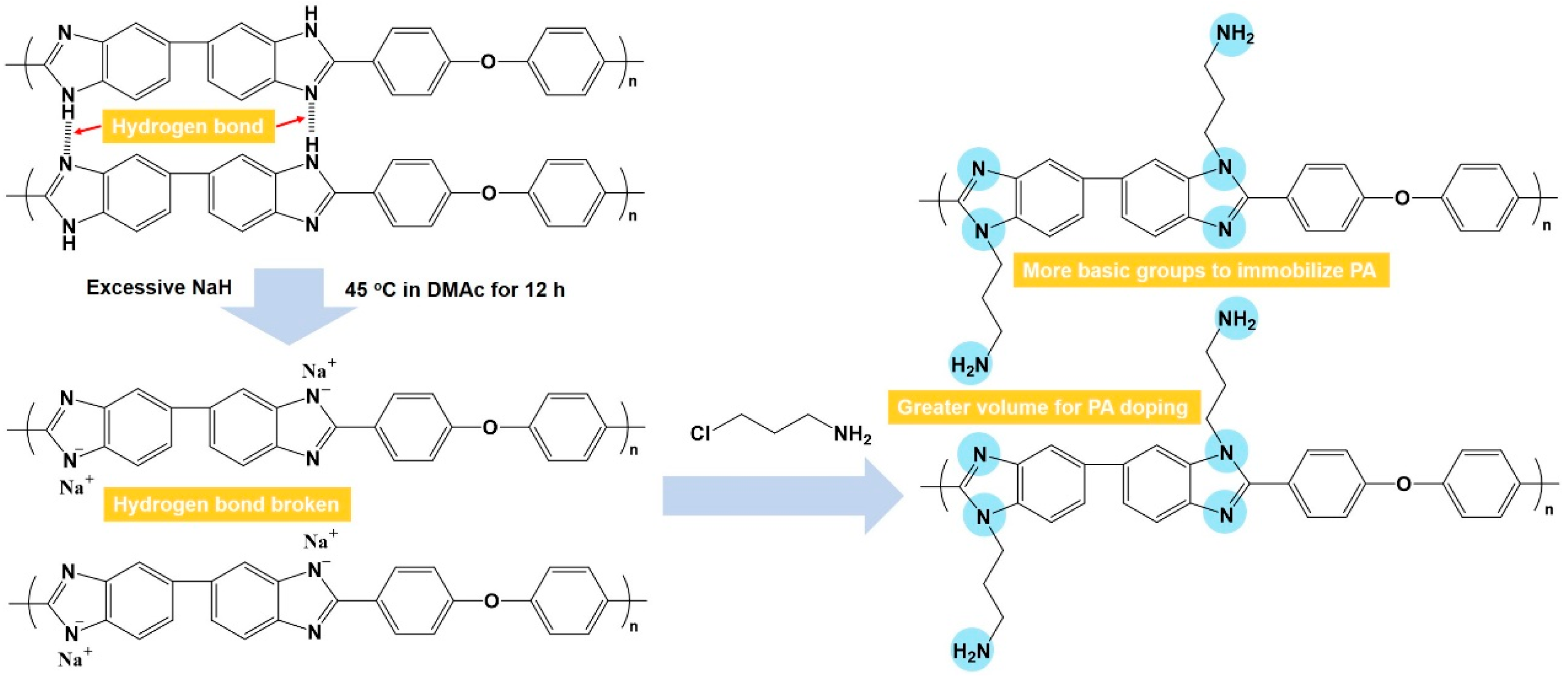
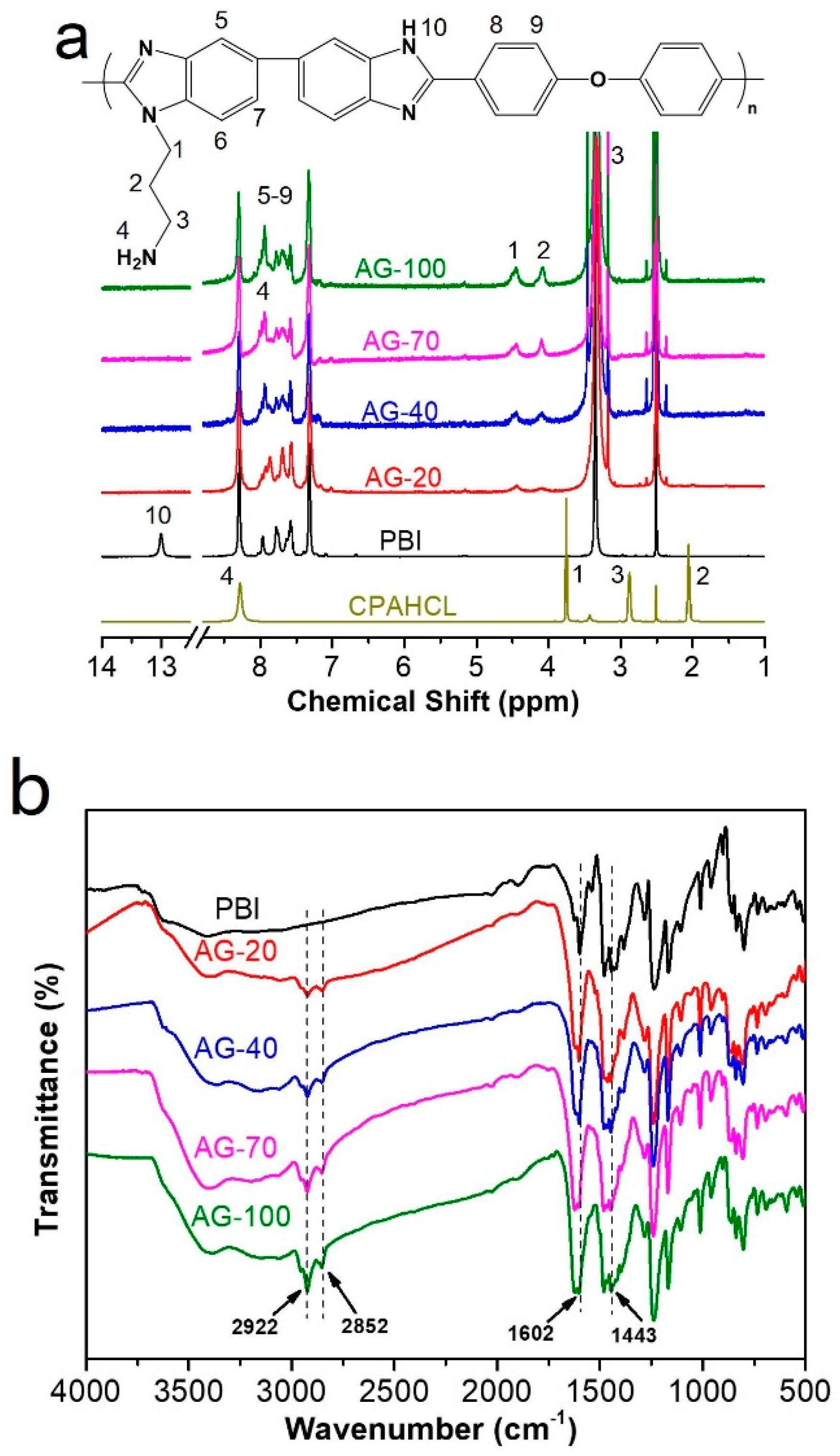

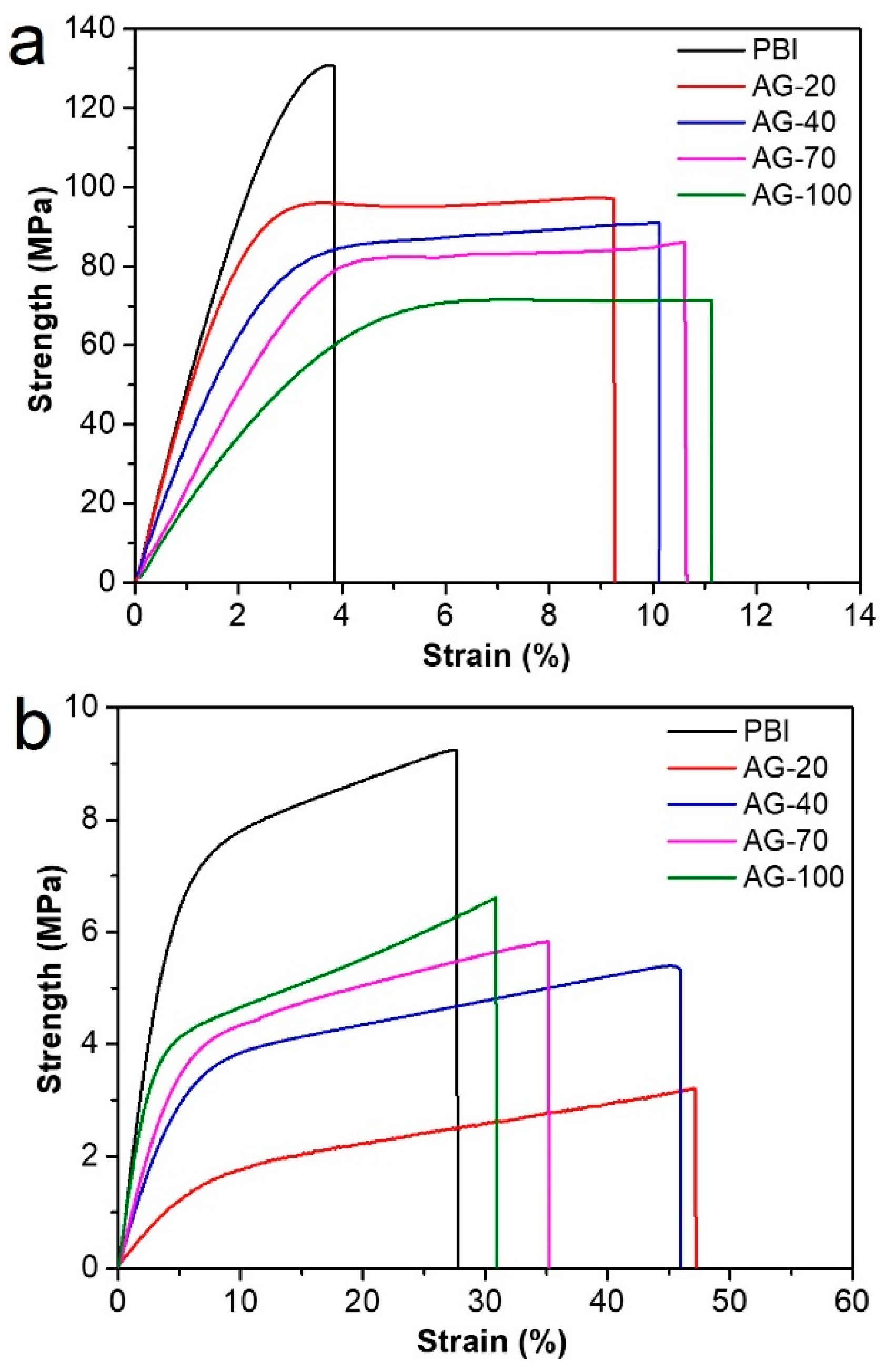
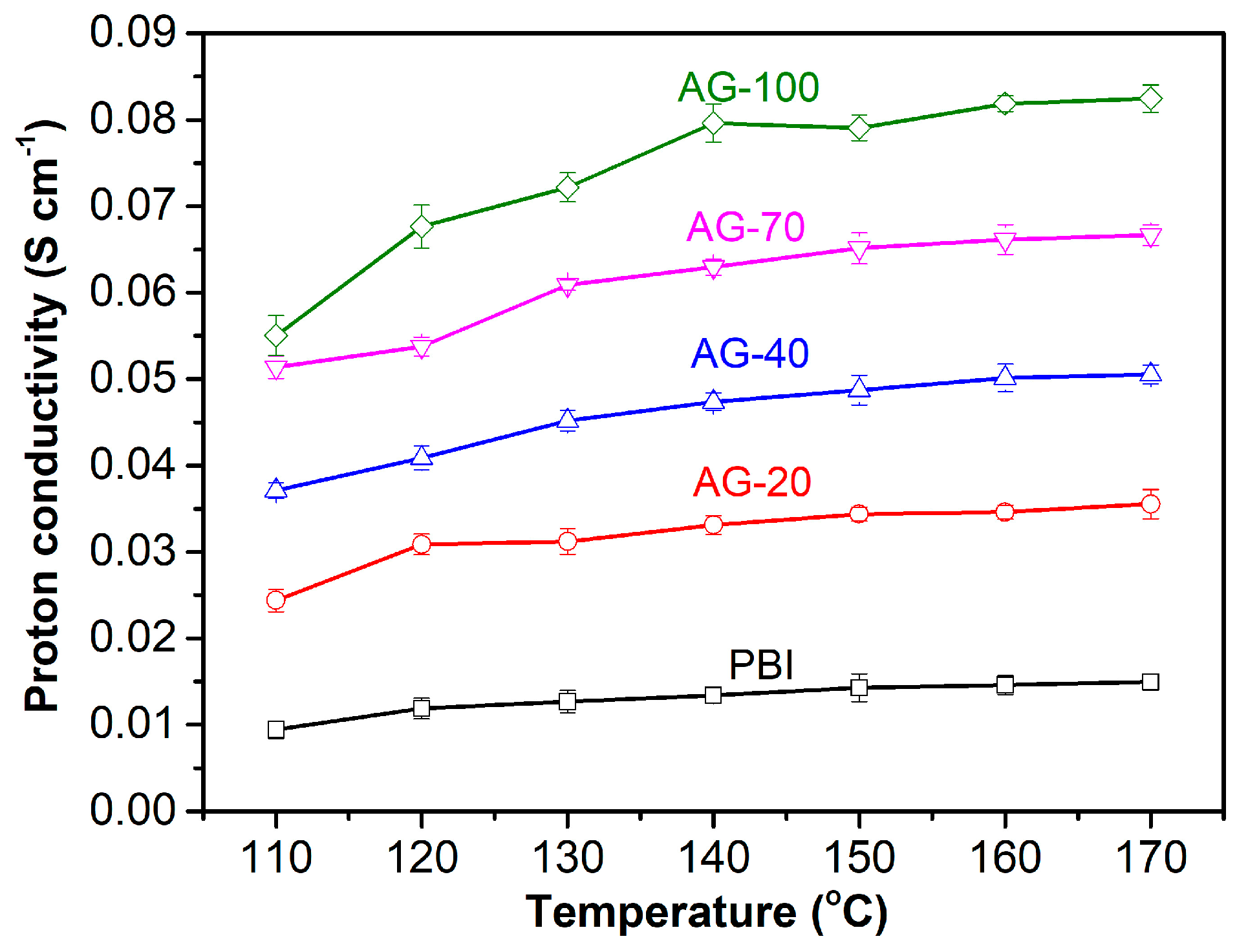
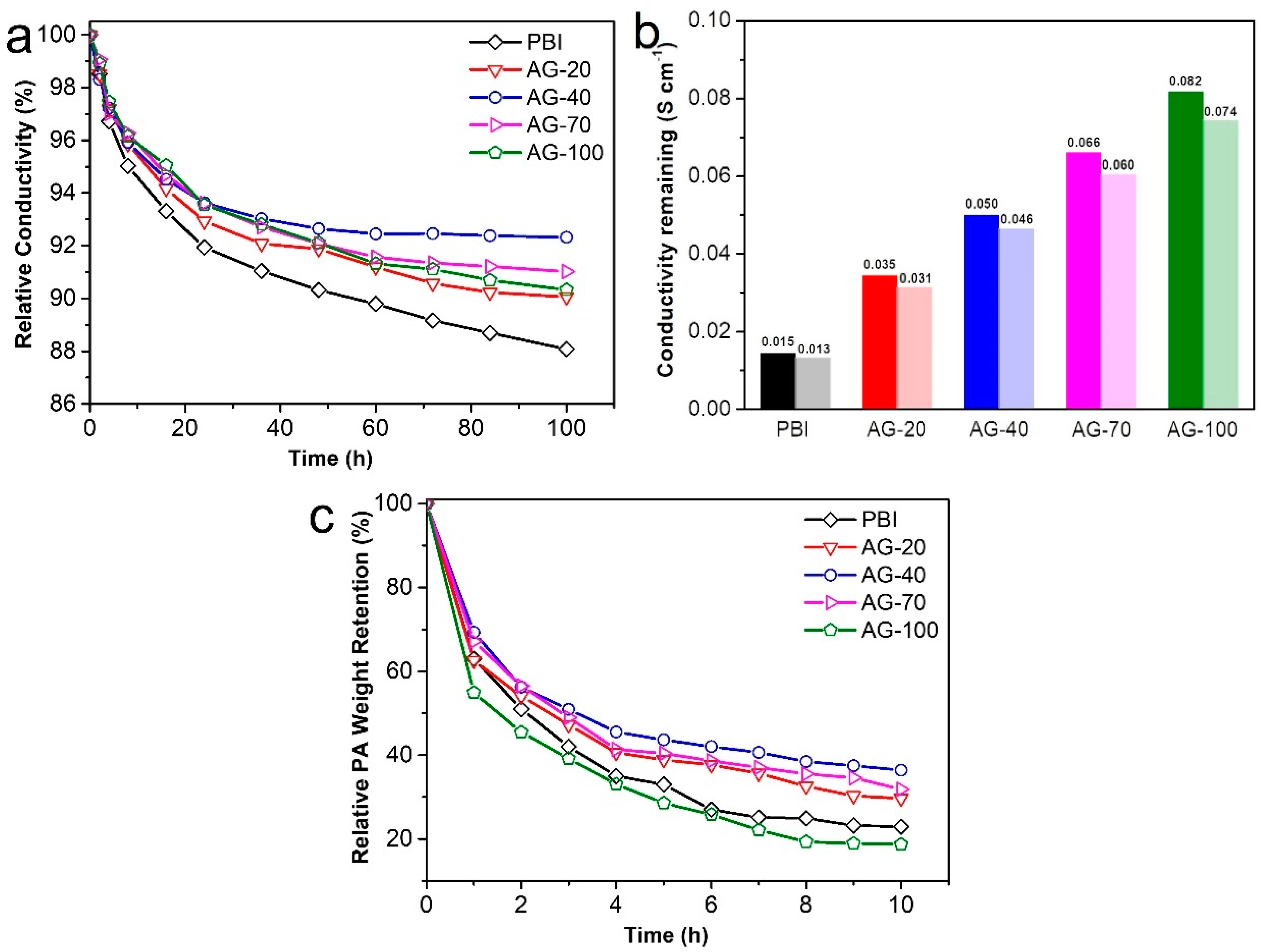


| Samples | τ3 (ns) | I3 (%) | R (Å) | FFV |
|---|---|---|---|---|
| PBI | 1.799 | 9.2 | 4.59 | 6.72 |
| AG-70 | 1.901 | 10.3 | 4.97 | 9.53 |
| Samples | GD (%) | PA Uptake (wt.%) | ADL | Swelling (%) |
|---|---|---|---|---|
| PBI | 0 | 202 ± 12.3 | 8 ± 0.5 | 131 ± 7.9 |
| AG-20 | 19.7 | 288 ± 11.8 | 12 ± 0.5 | 166 ± 8.8 |
| AG-40 | 38.1 | 330 ± 16.9 | 16 ± 0.8 | 191 ± 11.2 |
| AG-70 | 65.4 | 374 ± 23.5 | 18 ± 1.1 | 235 ± 18.7 |
| AG-100 | 91.2 | 433 ± 22.8 | 22 ± 1.2 | 284 ± 17.5 |
| Samples | Strength (MPa) | Elongation at Break (%) | Fracture Energy (103 kJm−3) | |||
|---|---|---|---|---|---|---|
| Undoped | Doped | Undoped | Doped | Undoped | Doped | |
| PBI | 130.8 ± 7.1 | 8.7 ± 1.5 | 3.8 ± 0.5 | 20.5 ± 2.7 | 3.1 ± 0.2 | 1.7 ± 0.2 |
| AG-20 | 97.3 ± 7.8 | 6.6 ± 1.8 | 9.3 ± 0.6 | 30.9 ± 2.2 | 7.8 ± 0.7 | 1.5 ± 0.1 |
| AG-40 | 91.0 ± 5.2 | 5.8 ± 2.3 | 10.1 ± 0.7 | 35.2 ± 3.1 | 7.6 ± 0.6 | 1.6 ± 0.2 |
| AG-70 | 86.0 ± 3.8 | 5.4 ± 1.7 | 10.6 ± 0.6 | 46.0 ± 2.9 | 7.3 ± 0.6 | 1.9 ± 0.2 |
| AG-100 | 71.5 ± 8.8 | 3.2 ± 1.8 | 11.1 ± 0.9 | 47.2 ±3.9 | 6.4 ±1.1 | 1.0 ± 0.1 |
| Membrane | Fuel Gas | Backpressure (kPa) | Pt Loading (mg cm−2) (Cathode) | Peak Power Density (W cm−2) | Ref. |
|---|---|---|---|---|---|
| AG-70 | H2, Air | 0 | 1 | 0.409 | This work |
| 200 | 1 | 0.638 | |||
| CTFs-OPBI | H2, O2 | 0 | 1 | 0.534 | [12] |
| AmPBI-Car-5 | H2, Air | 0 | 1.5 | 0.216 | [33] |
| PBI-Sc-5 | H2, Air | 0 | 1.5 | 0.411 | [38] |
| NbPBI-TPAm | H2, Air | 0 | 1.5 | 0.385 | [42] |
| PBI/sGO-2 | H2, Air | 0 | 1 | 0.364 | [43] |
| PBI/1Mus | H2, Air | 0 | 1 | 0.586 | [44] |
| L-10 | H2, Air | 0 | 0.6 | 0.438 | [45] |
| IPyPBIs | H2, O2 | 0 | 0.6 | 0.28 | [46] |
| QPANI-OPBI | H2, O2 | 0 | 0.6 | 0.459 | [47] |
| DPBI-10PVBC | H2, O2 | 0 | 0.4 | 0.405 | [48] |
| NPBI | H2, O2 | 0 | 0.5 | 0.632 | [49] |
| 1%-PBI | H2, O2 | 0 | 0.6 | 0.597 | [50] |
| PPA-PBI | H2, Air | 0 | 1 | ~0.6 | [51] |
| PPA-2,5-PPBI | H2, O2 | 0 | 1 | ~0.6 | [52] |
| PA-PBI | H2, Air | 300 | 1 | ~0.4 | [53] |
Disclaimer/Publisher’s Note: The statements, opinions and data contained in all publications are solely those of the individual author(s) and contributor(s) and not of MDPI and/or the editor(s). MDPI and/or the editor(s) disclaim responsibility for any injury to people or property resulting from any ideas, methods, instructions or products referred to in the content. |
© 2024 by the authors. Licensee MDPI, Basel, Switzerland. This article is an open access article distributed under the terms and conditions of the Creative Commons Attribution (CC BY) license (https://creativecommons.org/licenses/by/4.0/).
Share and Cite
Liu, G.; Pan, H.; Zhao, S.; Wang, Y.; Tang, H.; Zhang, H. Grafting of Amine End-Functionalized Side-Chain Polybenzimidazole Acid–Base Membrane with Enhanced Phosphoric Acid Retention Ability for High-Temperature Proton Exchange Membrane Fuel Cells. Molecules 2024, 29, 340. https://doi.org/10.3390/molecules29020340
Liu G, Pan H, Zhao S, Wang Y, Tang H, Zhang H. Grafting of Amine End-Functionalized Side-Chain Polybenzimidazole Acid–Base Membrane with Enhanced Phosphoric Acid Retention Ability for High-Temperature Proton Exchange Membrane Fuel Cells. Molecules. 2024; 29(2):340. https://doi.org/10.3390/molecules29020340
Chicago/Turabian StyleLiu, Guoliang, Hongfei Pan, Shengqiu Zhao, Yadong Wang, Haolin Tang, and Haining Zhang. 2024. "Grafting of Amine End-Functionalized Side-Chain Polybenzimidazole Acid–Base Membrane with Enhanced Phosphoric Acid Retention Ability for High-Temperature Proton Exchange Membrane Fuel Cells" Molecules 29, no. 2: 340. https://doi.org/10.3390/molecules29020340
APA StyleLiu, G., Pan, H., Zhao, S., Wang, Y., Tang, H., & Zhang, H. (2024). Grafting of Amine End-Functionalized Side-Chain Polybenzimidazole Acid–Base Membrane with Enhanced Phosphoric Acid Retention Ability for High-Temperature Proton Exchange Membrane Fuel Cells. Molecules, 29(2), 340. https://doi.org/10.3390/molecules29020340








